Physical comedy has been around since mankind discovered how much we wanted to laugh. Although physical comedy fell outside the decorum of Greek comedy, the Romans were willing to get a little physical. Many of the roots of contemporary physical comedy come from the Italian commedia dell’arte and the French farce.
Most forms of physical comedy are hardly subtle. Whether it’s a pie in the face, a pratfall, walking into a solid object, a house collapsing around you, loss of a trouser or skirt, runaway vehicles, fighting or fleeing; physical mishaps make people laugh. Admittedly, physical comedy is considered low comedy as opposed to high comedy which is based on the use of language, like wit, puns, word play or satire, but physical comedy is an art form and knowing how to direct and shoot it requires a very special set of skills.
Physical comedy can be used to lighten a mood or expand on a scene which has been mostly verbal. Taking most any scene and just making it bigger can many times lead to a piece of physical comedy. The scenes usually need to be stretched to include physical comedy, but that said, most of Shakespeare’s comedies, certainly some of the most sophisticated dialogue ever written, can be accompanied by very broad slapstick. Writers have often written slapstick to Shakespeare tragedies as a means of breaking the tension. You just have to find a way to integrate it into the body of the piece. Audiences love to see a villain trip, fall or stumble, we love to see the physical misfortunes of certain characters. We love Rob Petrie, the character Dick Van Dyke played on his 1961-1966 sitcom and as soon as he tripped over that ottoman in the opening credits we were ready for all the comedy that was to follow.
Physical Comedians
A pratfall is a safe way to fall down but many of the best physical comedians made a point of doing very risky stunts for laughs; funny danger, tragedy, comedy and the hysterical reaction of laughter upon seeing something awful. When the house front fell forward and Buster Keaton was spared by being in the door frame, or when he rode on the active pistons of a running locomotive, being risky made it funny. From Charlie Chaplin’s walk to his being hit by objects, or Harold Lloyd hanging from things high in the air made it a real stunt but also a funny one. Lloyd lost some fingers being funny, and he was a professional, point being, physical comedy is a skill. It can also be dangerous so always operate under the safety first rule of production. 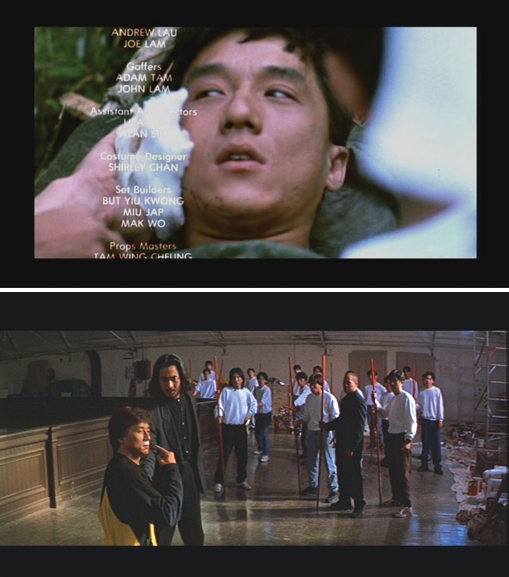
Jim Carrey and Robin Williams are both comedians who are as funny with their bodies and their faces as they are with their verbiage. Gene Wilder is the king of the “slow burn” and uses his slow build to an emotional explosion almost better than any comedian. In the 1977-1984 TV series Three’s Company's John Ritter had many episodes in which he was tripping over something. The sight gags and physical comedy of the Keystone Kops and the Mack Sennett comedies of the silent film era are also represented heavily in the Warner Brothers cartoons with the Road Runner and Wile E. Coyote and the MGM cartoons with Tom and Jerry. The character of Kramer on Seinfeld was famous for his entrances and exits, something he improvised as a gag that was then written into the show.
There are many styles and types of physical comedy, but mimes and clowns are both great sources to study because they tend to use physical comedy as their main form of storytelling through actions. They must set up their storyline, develop the story, and sell the punch line many times entirely through the body. Well known comedian Rowan Atkinson is probably best known for his physical humor. His character, Mr. Bean, never needed to say real words, just sounds, and he has created so many iconic moments of physical comedy, including getting a turkey stuck on his head and changing from a dress suit into a swimsuit, all while wearing the men’s dress suit, (you need to see it to believe it). Which is the point. As a director, you should study physical comedy in all its forms in order to come to understand it. Study Lucille Ball, Carol Burnett, Steve Martin, Jerry Lewis, Peter Sellers and learn from the masters.
Physical Comedy Techniques
Studying the elements of physical comedy and understanding what works will help you develop techniques that you can apply to your routines and avoid standard traps like telegraphing or anticipating what comes next. It’s hard to not flinch when you know a pie or a club or a wall is coming but it’s much funnier when it looks like it took you completely by surprise. Make sure the added elements of physical humor support and add to the content of the scene but don’t overpower it. The overall effect of the scene should be heightened by the added humor. However, well used physical humor can lighten the mood, heighten the comedy to become hilarious, add energy, add spectacle and help a scene “go over the top.”
Physical comedy is sometimes called slapstick. A slapstick was two pieces of thin wood put together during Shakespeare’s time as a safe way to make a cracking sound when it was slapped against another actor. This broad kind of hitting humor was also the focus of the Punch and Judy puppet shows that were created at the same time as the slapstick. This kind of humor walks a very fine line between being hysterically funny and somewhat brutal or violent. The timing in slapstick humor is just as important as it is in telling a good joke or delivering a successful punch line.
All forms of comedic acting are difficult, but physical comedy is equally complicated and as demanding as the correct delivery of scripted material. Theres a saying: “dying is easy; comedy is hard.” It’s been more than 400 years since Shakespeare put slapstick into some of his plays and slapstick is still going strong. The tone of the piece is what lets us laugh. The tone lets our subconscious know that someone who is suddenly hit by a bus and carried out of frame is actually all right, so it is both surprising and very funny. In real life if I walk right into a wall I’ll need a doctor or a dentist, but if Martin Short does it we know he is OK so it can only hurt our funny bone.
The tone of a physical comedy is what separates an acceptable stunt from a bad or inappropriate stunt. Tone is the difference between why America’s Funniest Home Videos are really funny and Jackass is extremely hard to watch for so many. We know they wouldn’t show a piece on America’s Funniest Home Videos where someone gets truly hurt. We don’t know that when we see the pain in Jackass. As long as the physical comedy suits the tone of your piece it can be used to increase its funny factor. If a physical comedy moment becomes so large that it buries the message of the scene, then you should consider reducing or removing it. A really funny moment that minimizes content won't work, unless the content doesn’t matter.
Integrating Physical Comedy
Integrating physical comedy into your film or video starts by putting it in your script or outline. Getting it into your film successfully involves the director, director of photography and many other creatives being able to translate what needs to be shot and how to shoot it during the pre-production period. The more detail you can record, the better the chance you have of everyone understanding the comedy bit and how it has to work to be funny. If possible, don’t just write “he falls” but write “he steps in a bucket which sticks to his left foot, causing him to ski down the grassy hill on one foot shooting him into the rose garden and tumbling into the thicket.” Producing that bit as written will involve not just shooting it but also finding a location that will work, prepping the bucket, the grass and the rose bushes and finding an actor who can do it. Depending on the level of your production, it might also involve a stunt coordinator. Being specific will take a fall and develop it into a piece of choreography. Writing this type of detail allows everyone connected with the project at that moment to dissect it, discuss it, prepare for it and successfully shoot it on time and on budget.
The director is the “buck stops here” person who must make the final decisions regarding how the bit will be conceived and ultimately shot. Bits require rehearsal. As an actor you should always be open to trying out whatever is in the director’s vision for the comic moment, but you should be forthright with your abilities and be open to input when appropriate. Some actors are better physical comedians than others. Get the moment “up on its feet,” and actually have the actors do the bit you have conceived; you might find it to be brilliant as soon as you work out each step in the process with the actors. If it isn’t, listen to the actors, their instincts are almost always good ones because they want to look good and make you look good. Keep it a collaborative art form. The more the actors take ownership, the funnier it will play. Comedy that becomes belabored stops being funny. Don’t be afraid of rehearsing comedy in advance, the process allows you to know it is going to work, that it is going to be funny and prep for any changes that you have created. You will also be able to work out any safety issues.
The director should make decisions about how real the bit needs to look. If it is violent such as a fight, the right camera angles can allow punches to miss by as many as six inches and still look as if contact was made. Sometimes however, the punch needs to land and the director needs to coach the talent to strike the other actor but not to drive the punch into the other person. It’s a delicate balance to get the actor to not “pull the punch,” which doesn’t look real, and hit but not hard. Certain parts of the body can take more of a punch without causing damage such as the stomach or a slap or backhand to the neck is more tolerable than anything to the face.
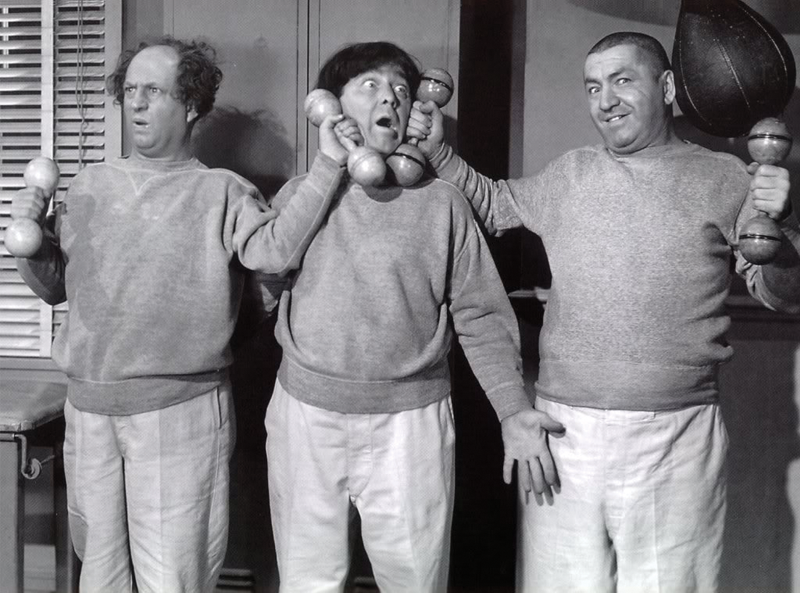
Certain effects, such as someone being hit by a car, can be shot with the person on the other side of the car and choosing a camera angle that “sells” the moment with the actor bending back and falling out of camera as the car passes. Then you set up a second shot with the actor laying behind the car as the car clears. These two shots edited together can give you the effect of someone being hit by a car. If you truly need to see an actor get thrown up onto a car hood you need a stunt person. If you want someone smacked out of frame by a truck, you need to lock down the camera into a stagnant shot and drive the car right up to the actor and stop at the first shot and then remove the actor and run through the shot with just the car driving out of frame both ways. That footage can then be used by a graphic artist to recreate the actor graphically and have him or her hit by the car in a special moment created between the editor and the graphic artist.
Directing Physical Comedy
Shooting physical comedy provides a multitude of options. Many times the easiest way to shoot something that moves is to shoot it in a wide shot, but that tends to minimize the facial expressions. There are bits that will work in full body shot and certainly some need to have elements of it shot in a full body shot.
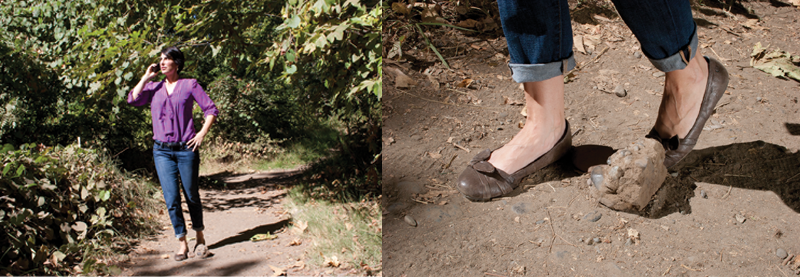
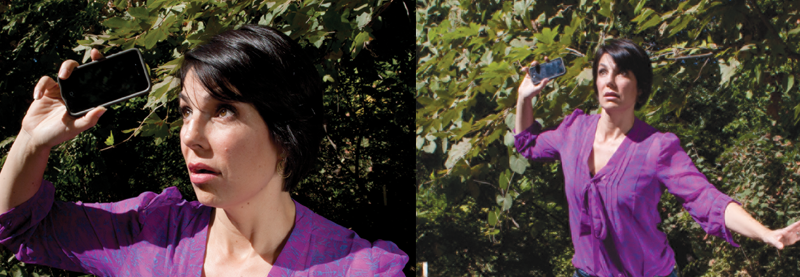
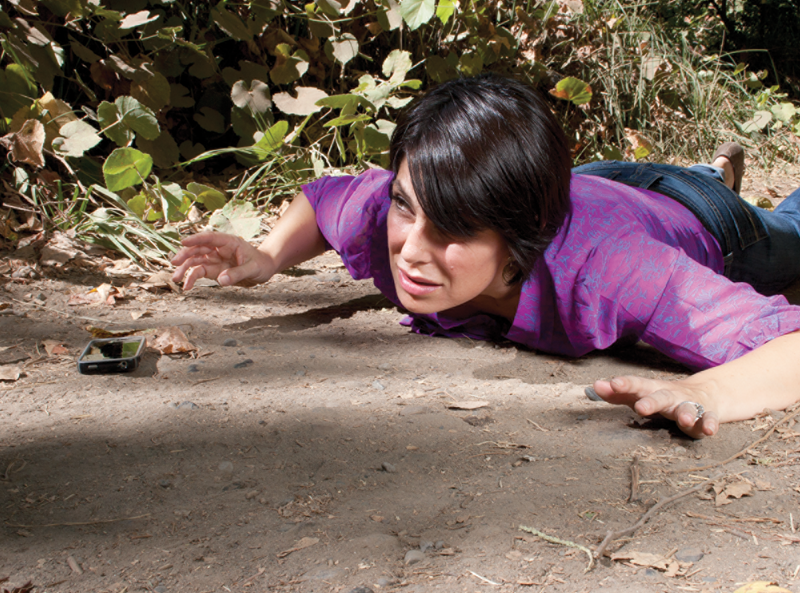
Shooting a physical bit that involves a significant amount of movement might be best shot in a combination of long shots and closeups and shot handheld or from a dolly or jib (all of which can follow the action). Movement is almost always exaggerated and seemingly increased in a camera. This means that you can often shoot physical comedy in near slow-motion or at least half speed and it will not seem slow when you replay it. This also means foot-lengths can seem like yards in the camera so you can reduce the actual amount of distance covered.
If you have a stabilizer, a dolly, a jib or if you are going handheld, you can experiment with how fast the camera moves following the action. All action will seem faster in the camera and the movement will seem more dynamic. You can also move the camera toward the event rather than following it if a dramatic moment is desired. Moving the camera toward something that is advancing toward the camera will seem to more than double the speed of the event. Editing these different styles of shooting together can sometimes deliver an end product that catches the energy of the physical bit and actually adds to the comedy. Other techniques that can add comedic flair are Dutch angles, (the camera canted at an angle) or high or low angle shots, (the camera placed low or high and tilted at the subject matter).
Experimenting with friends and a personal camera without any lighting or sound can still allow you to shoot from many angles and styles, recreating the physical comedy as you start to learn how a camera captures comedy. This process is very inexpensive and can give immediate input regarding styles of shooting comedy bits. The camera is a tool that can be used to not just capture the comedy, but to add to or create it. There are no rules that can’t be broken for the right reasons; no broken bones necessary.
Sidebar 1
Where to Find the Funny
Physical Comedians to Emulate
Rowan Atkinson, Lucille Ball, Mel Brooks, Carol Burnett, Steve Carell, Jackie Chan, Charlie Chaplin, Jim Carrey, John Cleese, Chevy Chase, Tim Conway, Dick Van Dyke, Chris Farley, Will Ferrell, Benny Hill, Buster Keaton, Don Knotts, Jerry Lewis, Harold Lloyd, Eddie Murphy, Bill Murray, Mike Myers, Leslie Nielsen, Richard Pryor, Michael Richards, John Ritter, Martin Short, Ben Stiller, Jim Varney, Gene Wilder, Robin Williams, and groups like: Laurel and Hardy, The Marx Brothers, and The Three Stooges.
Movies With Physical Comedy
A Fish Called Wanda, A Shot in the Dark (1964), Ace Ventura: Pet Detective, Anchorman: The Legend of Ron Burgundy, Airplane!, All of Me, Austin Powers: International Man of Mystery, Babes in Toyland, Bean, Blazing Saddles, Bridesmaids, Bringing Up Baby, Caddyshack, Christmas Vacation, Duck Soup, Groundhog Day, Monty Python and the Holy Grail, It’s a Mad Mad Mad Mad World, Roman Holiday, Safety Last!, Sons of the Desert, The Birdcage, The General (1926), The Flying Deuces, The Hangover, The Jerk, The Mask, The Tramp, The Philadelphia Story, The Producers (1967), Three Amigos, True Lies, Victor Victoria, Young Frankenstein, White Chicks and Zoolander.
Sidebar 2
Disclaimer: Be Safe Out There!
Unfamiliarity with the process of having actors fall, crash or get into unstable situations for the shot can be dangerous. Hollywood directors work with trained stunt people who study the craft and each situation carefully before attempting any pratfall or stunt. This story should be construed as theoretical advice. Videomaker, its editors and authors will not be held responsible for any injury due to the misuse or misunderstanding of any feature Videomaker publishes. This story cannot be construed as formal advice, Videomaker will not be held liable in any instance of an action resulting from this story, and Videomaker assumes all our readers will exercise good common sense. This disclaimer assigns the readers all responsibility for their own decisions.
Randal K. West is the Executive/Artistic Director for Way Off Broadway, Iowa’s only professional musical theatre company and is a writer/director of national television commercials.








